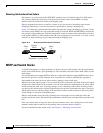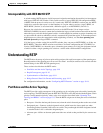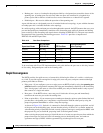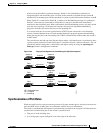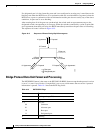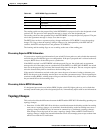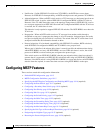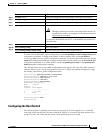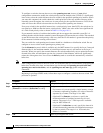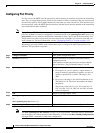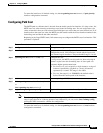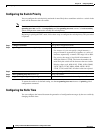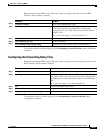
19-16
Catalyst 3750-E and 3560-E Switch Software Configuration Guide
OL-9775-02
Chapter 19 Configuring MSTP
Configuring MSTP Features
• VTP propagation of the MST configuration is not supported. However, you can manually configure
the MST configuration (region name, revision number, and VLAN-to-instance mapping) on each
switch within the MST region by using the command-line interface (CLI) or through the SNMP
support.
• For load-balancing across redundant paths in the network to work, all VLAN-to-instance mapping
assignments must match; otherwise, all traffic flows on a single link. You can achieve
load-balancing across a switch stack by manually configuring the path cost.
• All MST boundary ports must be forwarding for load-balancing between a PVST+ and an MST
cloud or between a rapid-PVST+ and an MST cloud. For this to occur, the IST master of the MST
cloud should also be the root of the CST. If the MST cloud consists of multiple MST regions, one
of the MST regions must contain the CST root, and all of the other MST regions must have a better
path to the root contained within the MST cloud than a path through the PVST+ or rapid-PVST+
cloud. You might have to manually configure the switches in the clouds.
• Partitioning the network into a large number of regions is not recommended. However, if this
situation is unavoidable, we recommend that you partition the switched LAN into smaller LANs
interconnected by routers or non-Layer 2 devices.
• For configuration guidelines about UplinkFast, BackboneFast, and cross-stack UplinkFast, see the
“Optional Spanning-Tree Configuration Guidelines” section on page 20-12.
Specifying the MST Region Configuration and Enabling MSTP
For two or more switches to be in the same MST region, they must have the same VLAN-to-instance
mapping, the same configuration revision number, and the same name.
A region can have one member or multiple members with the same MST configuration; each member
must be capable of processing RSTP BPDUs. There is no limit to the number of MST regions in a
network, but each region can only support up to 65 spanning-tree instances. You can assign a VLAN to
only one spanning-tree instance at a time.
Beginning in privileged EXEC mode, follow these steps to specify the MST region configuration and
enable MSTP. This procedure is required.
Command Purpose
Step 1
configure terminal Enter global configuration mode.
Step 2
spanning-tree mst configuration Enter MST configuration mode.
Step 3
instance instance-id vlan vlan-range Map VLANs to an MST instance.
• For instance-id, the range is 0 to 4094.
• For vlan vlan-range, the range is 1 to 4094.
When you map VLANs to an MST instance, the mapping is
incremental, and the VLANs specified in the command are added to
or removed from the VLANs that were previously mapped.
To specify a VLAN range, use a hyphen; for example, instance 1 vlan
1-63 maps VLANs 1 through 63 to MST instance 1.
To specify a VLAN series, use a comma; for example, instance 1 vlan 10,
20, 30 maps VLANs 10, 20, and 30 to MST instance 1.
Step 4
name name Specify the configuration name. The name string has a maximum length
of 32 characters and is case sensitive.



